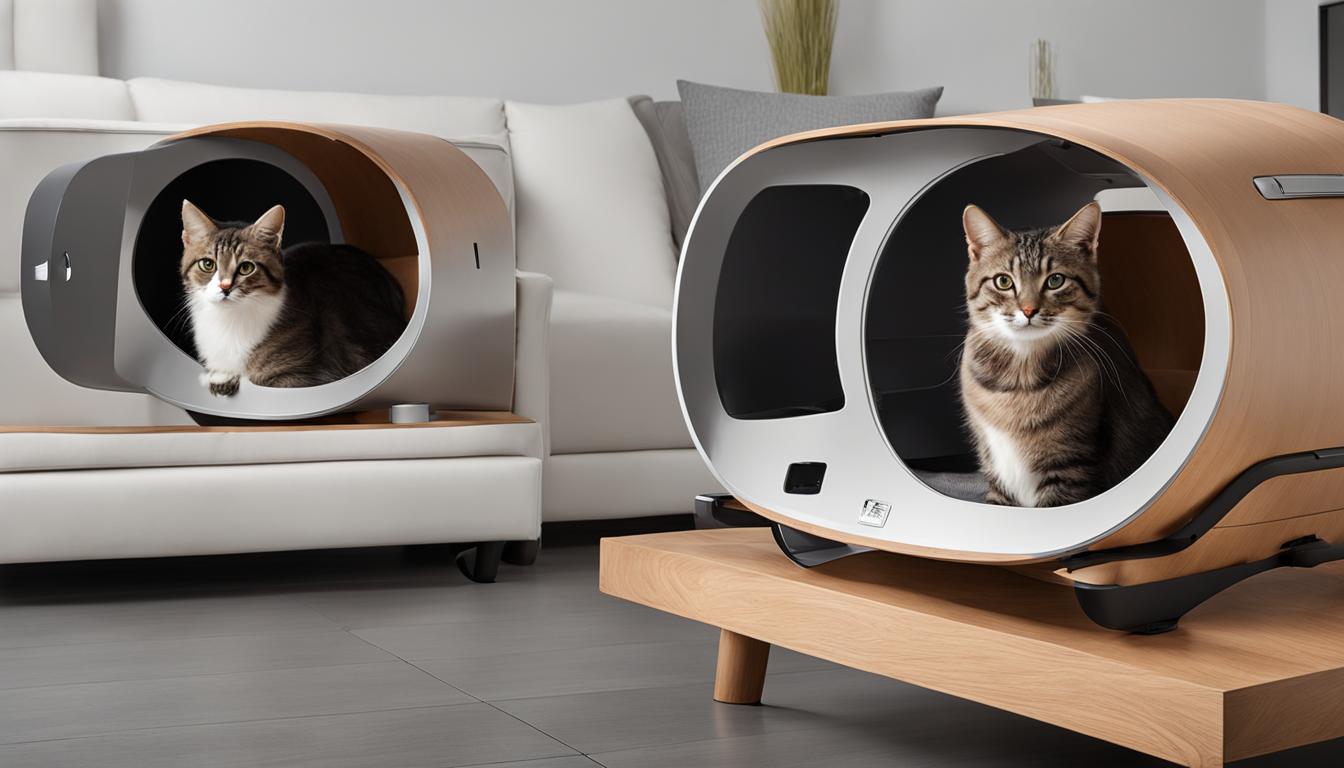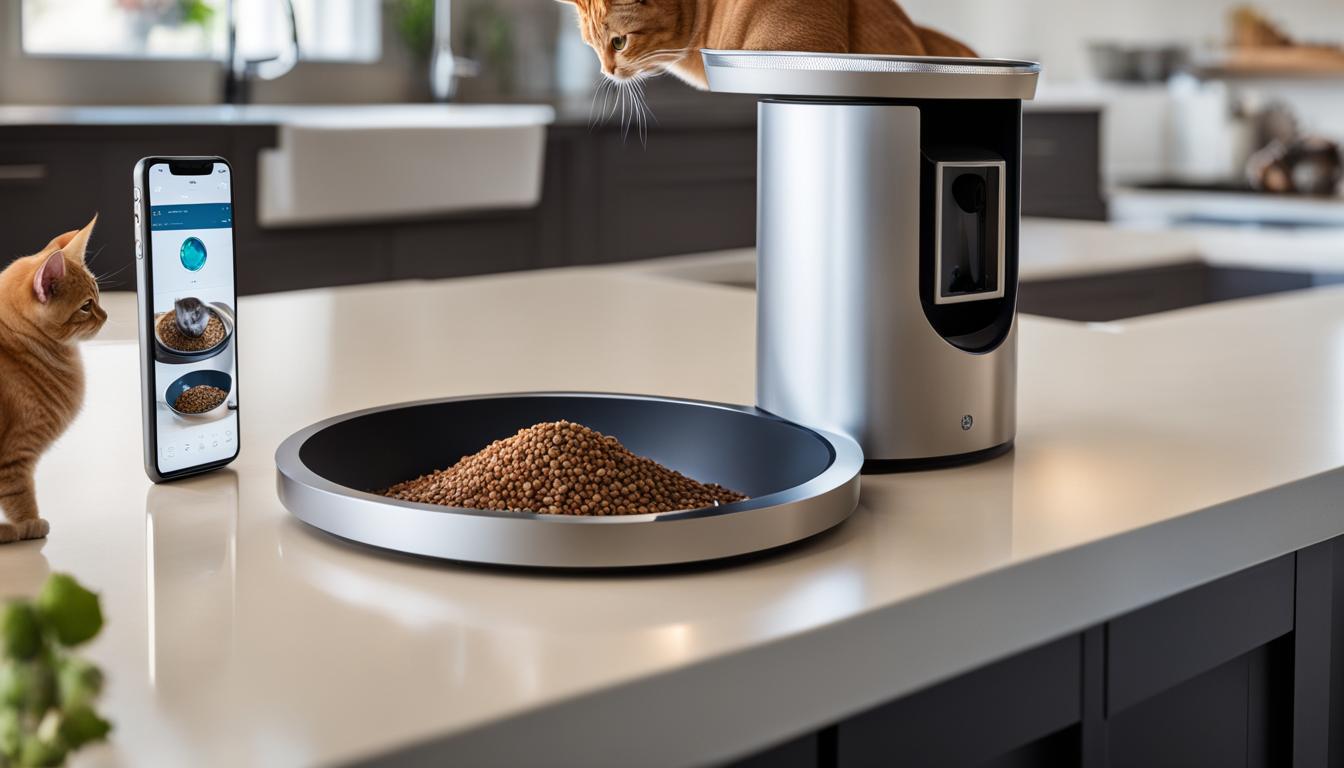Have you ever wondered how technology is shaping the way we understand cat nutrition? Well, let me enlighten you! In recent years, incredible advancements in technology have revolutionized feline dietary science, allowing us to delve deeper into the fascinating world of cat nutrition. From molecular techniques to gene-editing technology, our understanding of feline dietary needs has reached new heights.
Key Takeaways:
- Technological advancements have greatly impacted feline dietary research.
- Molecular techniques like sequencing and gene-editing have provided valuable insights into the composition and function of the feline microbiota.
- These advancements have the potential to improve cat nutrition and provide innovative solutions for cat allergies.
- Further research and development in technology hold exciting possibilities for future advancements in feline dietary science.
- Stay curious and be on the lookout for more exciting discoveries in the world of cat nutrition!
Feline Intestinal Microbiota: A Complex Ecosystem
The feline gastrointestinal tract harbors a diverse and complex community of microorganisms, known as the intestinal microbiota. This ecosystem consists of bacteria, archaea, viruses, fungi, and protozoa, all of which play a crucial role in maintaining the overall health of cats. Scientific studies on cat diets have revealed that the dominant bacterial phyla in the feline gut are Firmicutes, Bacteroidetes, Proteobacteria, and Actinobacteria. However, the relative abundances of these bacterial groups can vary among individuals and species.
The composition of the feline intestinal microbiota is influenced by various factors, including the cat’s living environment and diet. In recent years, technological advancements in feline dietary science have allowed for a more accurate understanding of the microbial composition in the feline gut. Molecular techniques such as sequencing have provided insights into the specific bacteria present in the microbiota and their potential functions. These advancements have shed light on the crucial role of the intestinal microbiota in cat nutrition and health.
To showcase the complexity of the feline intestinal microbiota, let’s take a closer look at a simplified table displaying the relative abundances of different bacterial phyla in the feline gut:
| Bacterial Phyla | Relative Abundance (%) |
|---|---|
| Firmicutes | 45 |
| Bacteroidetes | 30 |
| Proteobacteria | 15 |
| Actinobacteria | 10 |
This simplified table provides a glimpse into the diverse composition of the feline intestinal microbiota. The relative abundances of bacterial phyla can vary, emphasizing the importance of understanding how different factors, such as diet, influence the microbiota’s balance and function.
Innovations in Cat Food Analysis and Dietary Tech Solutions
Advancements in technology have revolutionized the way we analyze and understand cat food. Traditional cultivation methods, such as culturing bacteria from intestinal and fecal samples, have been replaced by molecular techniques that provide a more accurate characterization of the feline microbiota. These techniques, including fluorescence in situ hybridization (FISH), polymerase chain reaction (PCR), and sequencing, have allowed for a comprehensive understanding of the composition and function of the microbiota in a cat’s gastrointestinal tract.
One of the significant benefits of these technological advancements is the development of dietary tech solutions for cats. By gaining a deeper understanding of the feline microbiota, researchers have been able to identify the impact of different diets on the composition of the gut ecosystem. This knowledge has paved the way for the formulation of balanced cat diets that promote optimal nutrition and health. With the help of technology, cat food can now be tailored to meet the specific dietary needs of felines, ensuring they receive the essential nutrients required for their overall well-being.
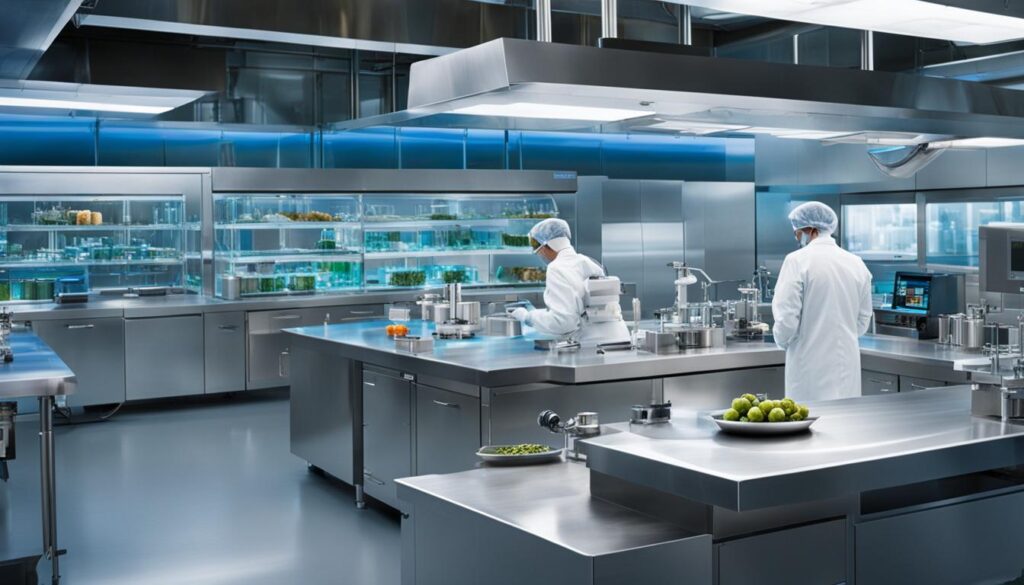
Additionally, technology has played a crucial role in enhancing the analysis of cat food. High-throughput sequencing techniques have allowed for the identification of previously uncharacterized bacterial groups in the feline gut. This information is valuable for ensuring the safety and quality of cat food, as well as developing innovative solutions for specific dietary requirements or health concerns. Through cutting-edge technology, the nutritional content of cat food can be precisely measured and optimized to provide a balanced and nutritious diet for feline companions.
Advantages of Technological Innovations in Cat Food Analysis:
- More accurate characterization of the feline microbiota
- Ability to tailor cat diets based on individual nutritional needs
- Identification of previously uncharacterized bacterial groups in the gut
- Precise measurement and optimization of nutritional content in cat food
With continued advancements in technology, the future of cat food analysis and dietary tech solutions holds exciting possibilities. Through ongoing research and development, we can expect further innovations that will enhance the nutritional value and safety of cat food, leading to healthier and happier feline companions.
Technology-Enhanced Cat Feeding and the Future of Cat Food Formulation
Advancements in technology have revolutionized the way we approach cat diet research and the formulation of cat food. With the development of various technological tools and techniques, we are now able to provide enhanced feeding solutions for our feline companions. From precision nutrition to personalized diets, technology has opened up new possibilities in cat food formulation.
One of the key areas where technology has made a significant impact is in the analysis of cat dietary needs. Through advanced molecular techniques, researchers have been able to gain deeper insights into the specific nutritional requirements of different cat breeds and individual cats. This knowledge has paved the way for the creation of tailored, technology-enhanced feeding solutions that can address the unique needs of each cat.
A prominent example of technology in cat food formulation is the use of gene-editing techniques to develop hypoallergenic cats. By targeting specific genes responsible for producing allergenic proteins, scientists have the potential to create cats that are safer for individuals with cat allergies. This breakthrough technology offers hope for those who have previously been unable to coexist with cats due to allergic reactions.
“Technology has given us the ability to delve deeper into the world of cat nutrition and find innovative solutions. From personalized diets to hypoallergenic cats, the possibilities are truly exciting.”
– Dr. Jane Foster, Feline Nutrition Expert
As we continue to harness the power of technology, the future of cat food formulation looks promising. With ongoing research and advancements in gene-editing technology, we may soon see a wide range of innovative products that cater to the unique dietary needs of our feline friends. By combining scientific knowledge with technological capabilities, we can ensure that cats receive the best possible nutrition for their overall health and well-being.
Table: The Future of Cat Food Formulation
| Technological Advancements | Impact on Cat Food Formulation |
|---|---|
| Precision nutrition | Customized diets based on individual cat’s needs |
| Gene-editing | Potential development of hypoallergenic cats |
| Data-driven formulation | Using big data and AI to optimize cat food composition |
| Functional ingredients | Inclusion of ingredients with specific health benefits |
As we look to the future, it is clear that technology will continue to play a crucial role in advancing feline nutrition and cat food formulation. With a better understanding of cat dietary needs and the ability to tailor diets to individual cats, we can ensure that our feline friends receive the best possible nutrition for a healthy and happy life.
The Prevalence of Cat Allergies and Current Solutions
Approximately 15% of people are allergic to cats, experiencing symptoms such as sneezing, congestion, and itchy eyes. Cat allergies can significantly impact the quality of life for individuals who love cats but are unable to coexist with them due to allergic reactions. While some cat breeds are believed to produce fewer allergens, scientific studies have yet to confirm this claim.
Current solutions for cat allergies include specialized pet food and vaccines that aim to reduce the amount of allergenic proteins in cats’ dander and saliva. These products work by either neutralizing the allergens or reducing the production of the proteins that trigger allergic reactions. However, it is important to note that these methods may not completely eliminate the allergen and may not be effective for all individuals. Each person’s immune system and sensitivity to specific allergens can vary, making it challenging to find a one-size-fits-all solution.

The Impact of Technology on Cat Allergy Research
Technological advancements have played a crucial role in advancing cat allergy research. Through scientific studies on cat diets and the use of molecular techniques, researchers have gained a better understanding of the genes and proteins associated with cat allergens. This knowledge has paved the way for innovative solutions, such as gene-editing technology, that have the potential to reduce or eliminate the production of allergenic proteins in cats.
“The development of gene-editing technology presents an innovative solution for individuals with cat allergies, potentially allowing them to safely coexist with cats.”
The use of gene-editing technology, specifically CRISPR, offers promising possibilities for creating hypoallergenic cats. By analyzing the DNA of domestic cats and wild cat species, researchers have identified specific regions along the genes responsible for allergenic proteins that can be edited using CRISPR. This approach aims to reduce or eliminate the production of the allergenic protein, making cats safer for individuals with cat allergies.
| Allergy Solution | Effectiveness | Potential Side Effects |
|---|---|---|
| Specialized Pet Food | Variable | Possible digestive issues |
| Allergy Vaccines | Variable | Possible allergic reactions to the vaccine |
| Gene-Editing Technology | Potentially high | Unknown long-term effects |
The Impact of Technology on Cat Allergy Research
Technology has played a crucial role in advancing cat allergy research, allowing scientists to delve deeper into the genetic and protein components associated with cat allergens. The use of molecular techniques, such as DNA sequencing, has provided valuable insights into the genes responsible for the production of the allergenic protein Fel d 1. Researchers have identified specific regions within these genes that can be targeted using gene-editing technology to reduce or eliminate the production of the allergenic protein.
This breakthrough in technology offers a promising solution for individuals who are allergic to cats. By gene-editing the DNA of cats, it may be possible to create hypoallergenic cats that produce significantly fewer allergens, making it easier for allergic individuals to coexist with these beloved pets. This innovative approach has the potential to transform the lives of cat allergy sufferers and open up new possibilities for cat ownership.
Furthermore, technological advancements have not only revolutionized cat allergy research but also paved the way for the development of new and innovative solutions. With a better understanding of the genes and proteins involved in cat allergies, researchers can explore alternative approaches to reducing allergenicity. This may include the development of specialized pet food formulations that are designed to minimize allergenic proteins or the creation of vaccines that target and neutralize specific allergens. The integration of technology into cat allergy research has the potential to improve the quality of life for individuals with cat allergies and expand the options available for managing their symptoms.
| Allergy Management Solutions | Effectiveness | Advantages |
|---|---|---|
| Specialized Pet Food | Moderate | Reduces allergenic proteins in dander and saliva |
| Vaccines | Variable | Target and neutralize specific allergens |
| Gene-Editing Technology | Potential | Reduces or eliminates production of allergenic proteins |
While these technological advancements offer promising solutions, it is important to note that further research is still needed. Cat allergy research is a complex and evolving field, and ongoing studies will continue to explore new technologies and approaches to managing cat allergies. Technology has provided a solid foundation for future research and the development of innovative solutions that have the potential to improve the lives of both cats and cat allergy sufferers.
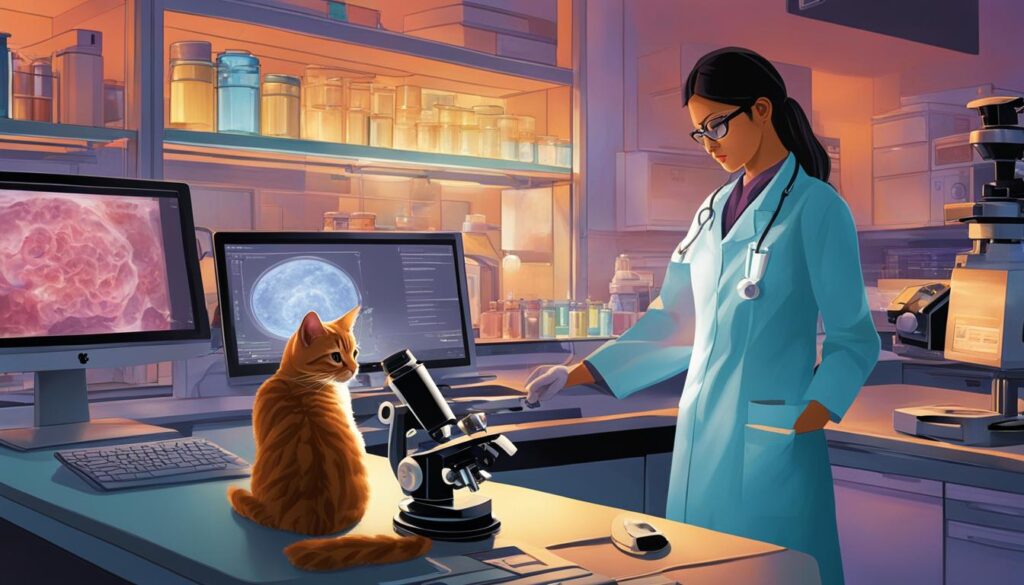
Future Directions in Feline Dietary Research and Cat Allergy Solutions
As technology continues to advance, there are exciting possibilities for further advancements in feline dietary research and cat allergy solutions. Ongoing studies will continue to explore the composition and function of the feline microbiota, with a focus on understanding how different diets impact the gut ecosystem. The use of high-throughput sequencing techniques will enable researchers to uncover new insights into the microbial diversity and metabolic capabilities of the feline gut. This knowledge can then be used to develop more tailored and effective dietary strategies for promoting optimal cat nutrition and health.
Additionally, the development of gene-editing technology holds promise for finding innovative solutions for cat allergies. While current methods such as specialized pet food and vaccines help reduce the allergenic proteins in cats, they may not be effective for all individuals. Gene-editing technology offers the potential for creating hypoallergenic cats by reducing or eliminating the production of the Fel d 1 allergenic protein. This research could have a significant impact on individuals with cat allergies, allowing them to safely coexist with these beloved pets.
Feline Dietary Science Advancements
Advancements in feline dietary science are not only focused on understanding the composition of the feline gut microbiota but also on developing innovative solutions for cat allergies. By leveraging technology, researchers aim to provide a deeper understanding of how different diets impact the gut ecosystem and overall feline health. This knowledge can then be used to develop targeted dietary interventions, such as specialized cat food formulations, to address specific nutritional needs or health concerns.
Innovations in Cat Food Analysis
The use of technology has also revolutionized cat food analysis, allowing for a more comprehensive understanding of the nutritional content of different cat food formulations. Through advanced analytical techniques, researchers and nutritionists can analyze the macronutrient and micronutrient composition of cat food and ensure that it meets the specific nutritional requirements of cats. Technology-enhanced cat feeding solutions, such as automated feeders that can dispense customized meals based on a cat’s individual needs, are also being developed to optimize feline nutrition and support their overall health and well-being.
Overall, the future of feline dietary research and cat allergy solutions looks promising with the continued advancements in technology. These advancements will contribute to a better understanding of feline nutrition and health, leading to the development of more effective dietary interventions and innovative solutions for individuals with cat allergies.
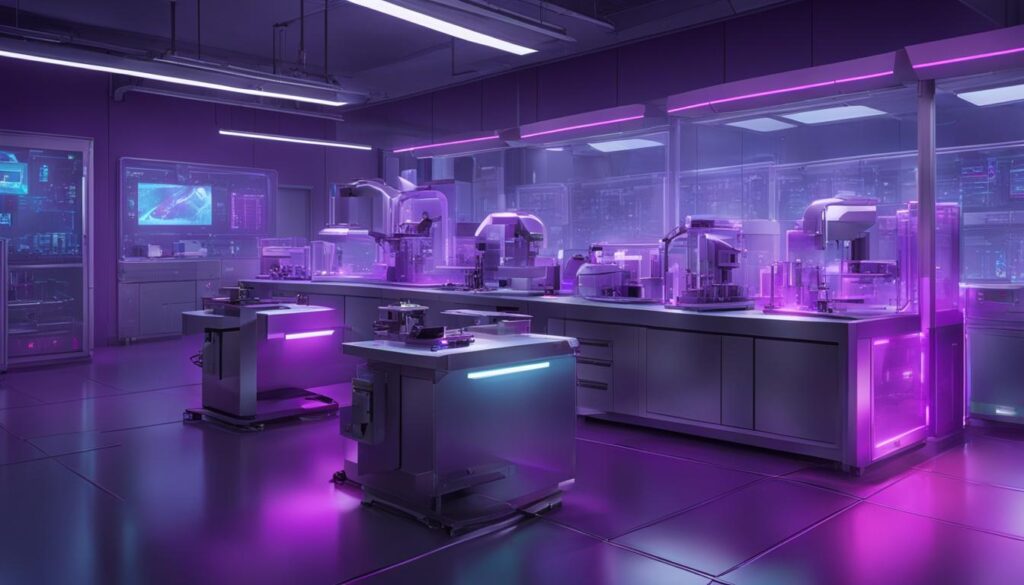
Conclusion
Wow, what an incredible journey through the world of feline dietary research and technological advancements! From molecular techniques to gene-editing, we’ve witnessed how technology has revolutionized our understanding of cat nutrition and health.
Thanks to innovations in cat food analysis, we now have a more comprehensive understanding of the composition and function of the feline microbiota. This knowledge has paved the way for the development of dietary tech solutions that can ensure balanced cat diets and enhance their overall well-being.
But the excitement doesn’t stop there. Scientific studies on cat diets have also explored the impact of exogenous factors, like diet, on the feline microbiota. Through technology-enhanced cat feeding and advancements in cat food formulation, we have the potential to optimize cat nutrition and promote their long-term health.
As we look to the future, it’s clear that technology will continue to play a vital role in feline dietary science. With ongoing research and development in feline nutrition technology, we can expect even more breakthroughs in understanding cat diets and finding solutions for cat allergies. The possibilities are endless, and I can’t wait to see what the future holds!
FAQ
What impact has technology had on feline dietary research?
Technological advancements have revolutionized our understanding of feline nutrition and health, allowing for a more comprehensive analysis of the composition and function of the feline microbiota, as well as the development of innovative solutions for cat allergies.
What is the composition of the feline intestinal microbiota?
The feline gastrointestinal tract is home to hundreds to thousands of microbial phylotypes, including bacteria, archaea, viruses, fungi, and protozoa. The dominant bacterial phyla in the feline gut are Firmicutes, Bacteroidetes, Proteobacteria, and Actinobacteria.
How have traditional cultivation methods been replaced with molecular techniques?
Traditional cultivation methods, which involved culturing bacteria from intestinal and fecal samples, have been replaced by molecular techniques like fluorescence in situ hybridization (FISH), polymerase chain reaction (PCR), and sequencing. These methods provide a more accurate understanding of the complex microbial ecosystem in the feline gastrointestinal tract.
Can gene-editing technology create hypoallergenic cats?
Yes, gene-editing technology, such as CRISPR, has the potential to create hypoallergenic cats by reducing or eliminating the production of the Fel d 1 protein, which is responsible for allergic reactions to cats.
What are the current solutions for cat allergies?
Current solutions for cat allergies include specialized pet food and vaccines that aim to reduce the amount of allergenic proteins in cats’ dander and saliva. However, these methods may not completely eliminate the allergen and may not be effective for all individuals.
How has technology impacted cat allergy research?
Technology, such as DNA sequencing and gene-editing, has allowed for a more detailed understanding of the genes and proteins associated with cat allergens. This has paved the way for the development of innovative solutions for cat allergies, potentially providing relief for individuals who are allergic to cats.
What are the future directions in feline dietary research and cat allergy solutions?
Future research will continue to explore the composition and function of the feline microbiota, as well as the impact of different diets on the gut ecosystem. Additionally, further research and development of gene-editing technology may lead to the production of hypoallergenic cats that can coexist with individuals who have cat allergies.


